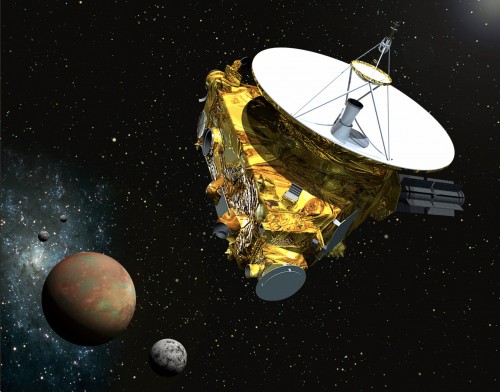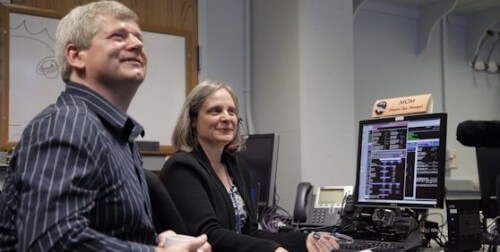The New Horizons spacecraft emerged from hibernation on December 6 for a close flyby of Pluto and its moons in 2015

After a journey of almost nine years and five billion kilometers - the farthest spacecraft in the history of the space program, New Horizons is about to reach its first destination.
The spacecraft's operators at the Applied Physics Laboratory at Johns Hopkins University in Maryland confirmed on Saturday at 21:53 EST (Sunday 04:53 Israel time) that New Horizons, which operates according to pre-programmed computer commands, went from hibernation to an active state.
The signals traveling at the speed of light took four hours and 26 minutes to travel the approximately 5 billion kilometers from Earth and over 260 million kilometers from the dwarf planet Pluto to be recorded by the Deep Space Network antennas near Canberra, Australia. "This event is the watershed where New Horizons crosses the vast ocean of space towards the outer reaches of the solar system, and begins to carry out the mission's main goal - the exploration of Pluto and its many moons in 2015," says Alan Stern, New Horizons' principal investigator from the Research Institute Southwest (SOUTHWEST RESEARCH INSTITUTE) in Boulder Colorado.
Since launching on January 19, 2006, New Horizons has spent 1,873 days - almost two-thirds of the flight time in a winter year. 18 separate periods of winter sleep from the middle of 2007 to the end of 2014, the length of which extended from 36 to 202 days. The team members used the winter year to save load on the spacecraft's components and reduce the risk of malfunctions.
"Technically this was routine because the awakening process had been performed many times" says Glenn Fountain, director of the New Horizons project at APL. "But from a symbolic point of view this is an important event, it means the beginning of the preparations for the meeting"
The wake-up sequence was programmed into a computer aboard the New Horizons in August. The order to execute it was scheduled for Saturday, December 6th at 15:00 PM EST. About ninety minutes later, New Horizons began broadcasting its status, including a report of its return to active status.
Members of the New Horizons team will spend the next few weeks inspecting the spacecraft, ensuring that its systems and scientific equipment are working as planned. They will also continue to develop and test the sequence of commands that will lead New Horizons to and tour the Pluto system.

With its seven scientific instruments, including infrared imaging systems and an ultraviolet spectrometer, a compact multi-color camera, a high-resolution telescopic camera, two powerful particle spectrometers and a space dust detector, New Horizons will begin observing the Pluto system starting on January 15. On July 14, New Horizons will be at its closest point to Pluto, but many discoveries are expected even before that. In mid-May, the spacecraft will be able to make a better observation of the Pluto system than is possible with the Hubble Space Telescope.
Demotion
For about seventy years, Pluto was considered the ninth planet in the solar system. Although it had some oddities, for example its orbit crossed that of Uranus and it was for a long time actually the eighth planet, but this was accepted. As the means of observation improved, it became clear that its true size is much smaller than the initial estimates. The size estimate was made possible following the discovery of Pluto's large moon Charon in 1978.
At the beginning of the 2006s, more ice-covered bodies were discovered one after the other in orbits similar to Pluto's, the diameter of some of them: Eris, Maka-Maka, Haumea, and Kwa-Wor larger than Pluto's. This led the World Astronomical Union in August XNUMX to dedicate the session of the union held in Prague to Pluto. after three days of discussions The participants decided by a small majority to change the definition of Pluto from a planet to a new definition - a dwarf planet. The spacecraft, which was launched to the planet eight months earlier, will pass in July 2015 across the system of the dwarf planet and its moons.
For information on the NASA website
More of the topic in Hayadan:

5 תגובות
My dear father
You mistakenly wrote that Pluto crosses the orbit of Uranus and it is not the case because Pluto crosses the orbit of Neptune. Please correct. I won't wake up anymore. It is enough to accuse Pluto of all kinds of lies
Good night
Yehuda
Thanks for the compliments.
Indeed it is a question of definition and Voyager and Pioneer spacecraft were sent to the big planets and then it is a bonus. On the other hand, New Horizons was destined for Pluto and after it passes by it, they will look for another target for it in the Kuiper belt.
A small recognition. It was noted that this is the most distant spacecraft in the history of the space program. Voyager 1+2 c bc and Pioneer 10 + 11 are further away. Perhaps it is more correct to say that this is the most distant research mission, the spacecraft with the highest speed.
Regardless of my comment, I really like reading the news on the science site, especially those related to astronomy and other foreign affairs. And very educated.
How amazing that information travels at the speed of light and is absorbed from five billion kilometers
overpowering
My dear father
Small mistake, please correct
The oddity of Pluto crossing Neptune's orbit. You wrote Uranus by mistake. Please correct.
Good night
Yehuda